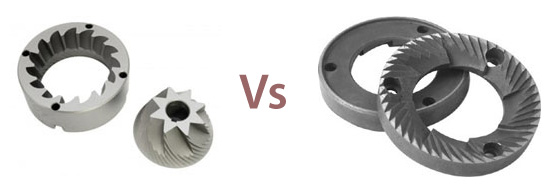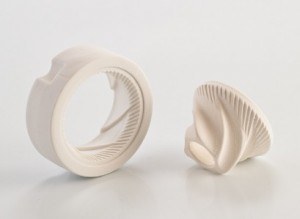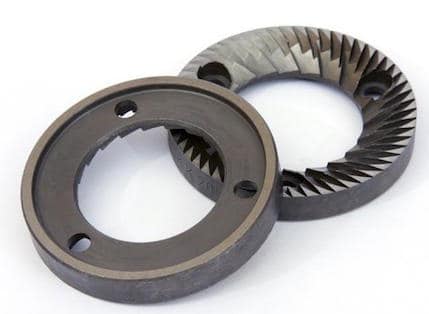The American desperate love of coffee has lead people to  do crazy things all the time.
do crazy things all the time.
When it comes to our caffeine needs, the ends sometimes justifies the means. We spend hundreds of dollars at local coffee shops. We jerry-rig makeshift coffee machines in less fortunate conditions all to get our morning-pick me up.
But sometimes we are hesitant about dropping a chunk of change in one sitting. High end coffee equipment is often deemed as hoity toity or unnecessary, even though quality of coffee is absolutely essential.
Give me a chance to convince you that it’s worth your while to take the leap.
First off, chuck out your grocery store-bought blade grinder. Even though it’s better than buying pre-ground coffee, it’s not doing a sufficient job.
In my previous post The Coffee Grinder: Burr vs. Blade Compared, I dissected the blade grinder and broke down how they work.
Essentially, the propeller hacks away at the beans, rending them incongurent.
The variance in particle size causes under and over extraction. This discrepancy leads to the weird tasting cups coffee and inconsistent batches from day to day.

What is an extraction?
You’ve probably heard this term in high school chem. But if it’s been… a while, let’s do the time warp again!
We’ll revisit the vocabulary and then see how the science works together to generate the coffee drinks we know and love.
The word, “extraction” is synonymous with the word, “solute.” They are the substances that are dissolved into the liquid of “solvent.”
So in the case of our coffee, the solute is the flavour particles within the beans, and the solvent is the water!
Easy as that!
So when you hear barista lingo like, “extraction time” you will know that it is just the time it takes for coffee to be brewed correctly.
The smaller the surface area, the faster the extraction. So the more fine you grind your beans, the less time it needs to yield the proper taste. And the opposite is equally true. The coarser the grinds are, the more time you need.
So you see how the blade grinder is problematic when you want a quality cup of joe?
The inconsistency of grind means that the different particles are either not getting enough time, or are getting too much time. That’s where the bitterness and the blandness comes from.
Have no fear! The burr grinders are here!
Yes, grinDERS. Plural. You have choices. And all are better than the blade.
Let’s get right to it!
What is a Burr?
It is a rough edge or ridge left on an object (especially of metal.)
They hide in all the most obvious of places. If you’ve ever used a hand crank peppercorn grinder, if you’ve ever seen a wheat mill on a farm, you’ve heard a burr. The whirring sound is the clock-like pieces being operated by a either a crank or a motor.
Conical Burrs vs Flat Burrs: What’s the Difference?
Let’s talk about the mechanics of each burr grinder so you can decide which is best for you.<
Conical burrs
 When we take apart a grinder with conical burrs, we see that it is made up of circle with sharp ridges. When you take that piece out, we are left with the spinning piece that is shaped like a cone with a rounded top.
When we take apart a grinder with conical burrs, we see that it is made up of circle with sharp ridges. When you take that piece out, we are left with the spinning piece that is shaped like a cone with a rounded top.
The preliminary stage to this gauntlet of grounds are a wide set of teeth with small serrated edges that break the whole bean down. Then gravity has its way and they are then passed to the next set until the reach their final grind set size and fall through the bottom.
The biggest perk to this shape is that the motor runs at a low RPM (revolutions per minute.) Though it is slower than the flats that have high RPM, conical burrs create less noise (and less angry roommates,) but most importantly, less heat, which means there is little to no chance of damage to the beans.
Here’s the kicker
To the naked eye, the conical burr grinder makes even, precise grinds. And to an extent that is absolutely true. Because of the nature of the shape, conical burrs produce grinds in bimodal distribution. This is a microscopic variance, creating 2 distinctive subset within the grind: fines and larger molecules. This “flaw” actually has an affinity for making great for espresso. The fines extract more quickly, allowing the water to continue through the portafilter. The larger pieces continue to extract and then follow suit.
Now you may be thinking that this completely negates my argument against the blade grinder. But the minuscule difference in the two groups is consistent, rending the whole batch consistent, smooth and strong.
There is some disagreement among baristas about whether or not you should sieve the fines to get a true extraction. The people who are perpetuators of this notion typically go the easier route and get a grinder with flat burrs.
The Flat burr
Unlike the conical, the flat burr grinder has two identical pieces that sit flush against each other.
The hopper feeds the beans into the first set of teeth at the center gap between the two pieces circle shaped metal. This time, the grinding action is horizontal. So we can’t depend on gravity to move the process along. Instead, there are little arm-like pieces which help guide the beans from tier to tier until they fall out at the perimeter of the circles, in the set grind size.
Flat burrs make the best espresso grinders because of the design, but they tend to be a little more spendy.
For a great example of the two different types of burrs, check out my article: Gaggia MDF vs Encore.
Now that we have established the differences between flat andconicalburrs, let’s talk about our other options.
There are two materials that those burrs can be made of:
Materials:
Burrs are typically made of one of these who materials: ceramic or stainless steel.

Ceramic burrs are made with a mold and are therefore more expensive to purchase initially and
toreplace should anything go awry.
They stay sharp forever if they are well taken care of. It’s important to check your beans by hand, rather than just dumping them from the container into the hopper, to ensure that there aren’t potential hazards.
Stainless Steel burrs are easy to make and replace. Factories use high-tech machinery cuts these by the thousand.
 The blades do a good job cutting through natural stowaways like twigs, I would still recommend a thorough scan of every fistful of beans. They do dull when used in a commercial setting and if they are working twice as hard to break down foreign substances, they may need to be replaced or sharpened more often.
The blades do a good job cutting through natural stowaways like twigs, I would still recommend a thorough scan of every fistful of beans. They do dull when used in a commercial setting and if they are working twice as hard to break down foreign substances, they may need to be replaced or sharpened more often.
Both materials work very well, the thing to think about is whether or not you will be using this for a mass or personal purposes.
Mechanics:
Manual burr grinders are perfect for small amounts of coffee. They’re relatively inexpensive and makethe grinding process even more personal. Using one of these is less of a hassle because you’re not depending on electricity. It’s much more tactile, so you can feel if there is a catch and check that immediately, rather than panicking to turn off a machine to see what happened.
For some of the best small grinders available check out our listing here. You can also check out a collection of super classy vintage style box grinders here.
 Electric (woogie woogie woogie) burr grinders come in all shapes and sizes. I would recommend starting small.
Electric (woogie woogie woogie) burr grinders come in all shapes and sizes. I would recommend starting small.
There are a few great ones on sale in our shop.
They’re simple to use, relatively inexpensive. They seem like a more calculated risk if you plan on using your new grinder at home, not in a business setting.
Regardless of which combinations you decide upon, having freshly ground coffee is the best choice.
